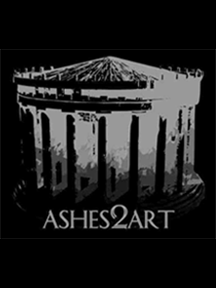By Kayla Meyers
Ancient monuments, such as those in Delphi, Greece, attract thousands of international tourists each year even as much of the monuments stand in ruin. As one walks around the broken columns of the Temple of Athena Pronaia, or the Temple of Apollo, it is natural to wonder what these ancient monuments once looked like. Were these dull blocks once lavishly painted? What kind of door was in that archway? The Ashes2Art project, co-founded by Phi Beta Kappa member Arne Flaten and Paul Olsen, endeavors to answer those kinds of questions at Coastal Carolina University. Flaten and Olsen work with students to digitally reconstruct and archive these monuments through hands-on research and 3D computer modeling technology. The teaching methods that Flaten and Olsen employ in the Ashes2Art project push the boundaries of traditional in-class teaching.
The Ashes2Art project started as a way for Flaten and Olsen to integrate various modes of teaching to break down disciplinary boundaries. The Ashes2Art course at Coastal Carolina University is cross-listed as an art history, history, and visual art course, but it also integrates computer science and various other skills. Flaten claims that “the whole concept was intended to be interdisciplinary.” He further says that the disciplines that the project engages in change from year to year depending on the students that are admitted to the program. Students who make up the program come from diverse fields ranging from political science to marine science, even though it is a humanities course. Flaten considers the program to function like a “think tank” where students can express their different interests and use the course as a vehicle to accomplish their individual goals. “They do the research for and create the website that contains lesson plans for K through 12 teachers and links to articles and other appropriate information for educators using our site,” says Olsen, showing that the students influence not only the teaching direction of Flaten and Olsen, but also other educators.
The Ashes2Art project also works to incorporate new technologies into the field of humanities. It is hard to imagine a class that both focuses on ancient Greek architecture and history while simultaneously working with 3D imaging software. When asked if knowledge of computer science is a hindrance for students, or whether they need extensive computer knowledge to get in the course, Flaten states, “No, which is not the answer you would expect. We recruit students with particular skills, but the extent to which the software is used depends on the interests of the students.” He also says that if students come in without computer skills, but are still interested in the software, they must teach themselves the software, requiring intense motivation. In the end, Flaten says, “students learn about ancient Greece, and walk away with a computer skill set that we are not teaching them.”
What differentiates the Ashes2Art course from other college courses is its reliance on student initiative. The interests and motivation of the students influence the direction the course. Flaten comments on his role as the co-director of the project saying, “I’m in a position to help them make judgments on whether something is feasible during one semester or in a budget, or how the molding of a doorway would have looked” but how those monuments are explored is up to the students.
The project has not only crossed disciplinary boundaries, but international ones as well. While the project has focused primarily on an English speaking audience, the its reach is certainly international. Ashes2Art received an award in Spain a few years back, and was given a computer kiosk in Seville to explain the project. Only then did Flaten realize that “most people there would not be speaking English as a first language.” He had to create a video that could be easily understood by non-English speakers, so voiceovers were replaced by basic text. Flaten says, “We’ve lectured on the project in China, Berlin, Egypt, Spain, and Budapest, but we are still finishing our work in Greece.” The excavation reports for Delphi are written in French, and the students must translate those on their own or seek outside assistance, giving them experience with different languages.
The Ashes2Art project has also collaborated with other universities, having completed a two-year partnership with Arkansas State University. When considering the future direction of the project Flaten says, “We are looking across the globe. Places in China, Crete, and Turkey have expressed interest. We are eager to work with other universities who may want to collaborate. Nothing is certain, but we’d be interested in having that conversation. We are excited by that uncertainty.”
Unlike most learning experiences that focus on answers, Flaten believes that the Ashes2Art project is fueled by uncertainty. “We have used three main points as guiding principles,” says Flaten, “1. Precision does not imply accuracy; 2. Questions are more important than answers; and 3. Uncertainty is crucial to knowledge.” It is this uncertainty that piques Flaten’s interest and drives his career as an educator, as his experience with the Ashes2Art project has been a learning experiment for the students and him alike. “When one really starts to study something is when he or she realizes how little he or she knows,” concludes Flaten, as he continues to push the boundaries of traditional teaching in the Ashes2Art project.
Kayla Meyers is a junior at the College of William & Mary majoring in American studies and English. William & Mary is home to the Alpha of Virginia chapter of Phi Beta Kappa.




